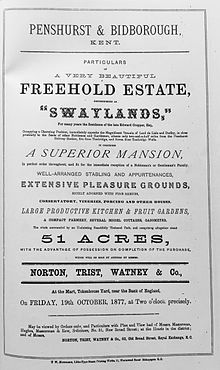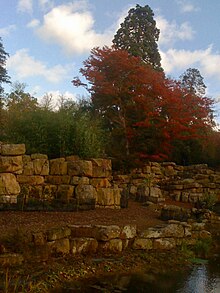Swaylands
Swaylands is a private parkland estate set high upon the Kentish Weald, on the edge of the village of Penshurst in the Sevenoaks district of Kent, England.
The three main apartment buildings on the Estate are, from north to south, Drummond Hall, Swaylands House and Woodgate Manor, which together fall within the Sevenoaks district.
Situated wholly within the High Weald Area of Outstanding Natural Beauty, the Estate comprises over forty acres of terraced gardens and grounds, featuring a rockery, a cricket pitch and its listed pavilion, a tennis court, a rose garden, a pond, a lake, waterfalls and a small landscape park, all of which were developed through the second half of the nineteenth century.
When William Woodgate built this three gabled villa on the top of the hill, it was described as a smaller version of his birthplace, Somerhill House, in Tonbridge.
By this time, William Woodgate had experienced financial difficulties, was suffering ill health and returned to his home in Cumberland Terrace, London.
Mrs Frances Allnut, from the Grove, Penshurst, recorded on 6 August 1859 “The bells rang merrily for Mr and Mrs Cropper coming to Swaylands, having painted and prepared the house.” In the 1870s Cropper employed the prominent Victorian architect[2] George Devey to extend greatly the house and to terrace the gardens.
Edward Cropper died in 1877 and, despite all the improvements he had made to Swaylands, his widow put the estate on the market and moved back to Pembrokeshire.
When the Swaylands estate was advertised in The Times by Norton, Trist, Watney & Co. in September 1877, the sale document described a very desirable property “in perfect order throughout, and fit for the immediate reception of a Nobleman's or Gentleman’s family”.
By this time it had a miniature gas works, vinery and specimen shrubs and trees, including a splendid Wellingtonia planted by Harriet Beecher Stowe.
Swaylands was purchased by the banker George James Drummond following an auction of "a superior mansion" at the Mart, Tokenhouse Yard, near the Bank of England in London on 19 October 1877.
George Drummond commissioned the arts and crafts architect, Sir Mervyn E. Macartney to build the vast elongated mansion that it is today.
The stated objectives of the Cassel Hospital were “To treat persons suffering from nervous disorders on the terms of patients contributing some portion of the cost of their maintenance.
To carry on… research work in connection with such disorders.” There were various minor alterations made to the interior of the building at Swaylands in order that it may function as a hospital for 54 patients.
The financial problems coincided with a national change in thinking about the efficacy of sending such children to a location distant, and different, from their homes.
Gama International bought Swaylands in 1995 with the intention of developing a health centre, but 5 years later the necessary money and planning permission was not forthcoming and the estate was sold for less than the purchase price.
Towards the end of the restoration of the main house and gardens, Heritable Capital Partners Limited entered administration (on 15 October 2008),[5] a victim of the global financial crisis.
[7] The long, Tudor-style, building has a main south front of three storeys with a projecting three-bay centre and an octagonal battlemented corner tower.
Hope Constable's building firm provided stonemasons to arrange the massive sandstone boulders which are from a quarry in nearby Langton Green.
Waterfalls and lakes completed the design and were fed by a combination of rainwater and water pumped from the nearby Medway river.
This garden building is surrounded by trees and looks onto an expanse of level lawn lying to the south-west (formerly the cricket pitch), the northern edge of which is marked by a path bordered with yews.
Edward Cropper was a director of the British and Irish Magnetic Telegraph Company and he owned interests in slate quarries in Pembrokeshire.
George married a granddaughter of the Duke of Rutland, Elizabeth Cecile Sophia Norman, with whom he lived at Swaylands.
I am simply miserable about him.”[citation needed] Sir Ernest Cassel from 1919 The freehold of the Estate is today privately owned by its residents.
George Drummond often entertained his close friend the Prince of Wales – later to become King Edward VII – at Swaylands.
[12] Visitors to Swaylands included the writer and poet Siegfried Sassoon, and the author of the stage play and book, Peter Pan, J. M.














